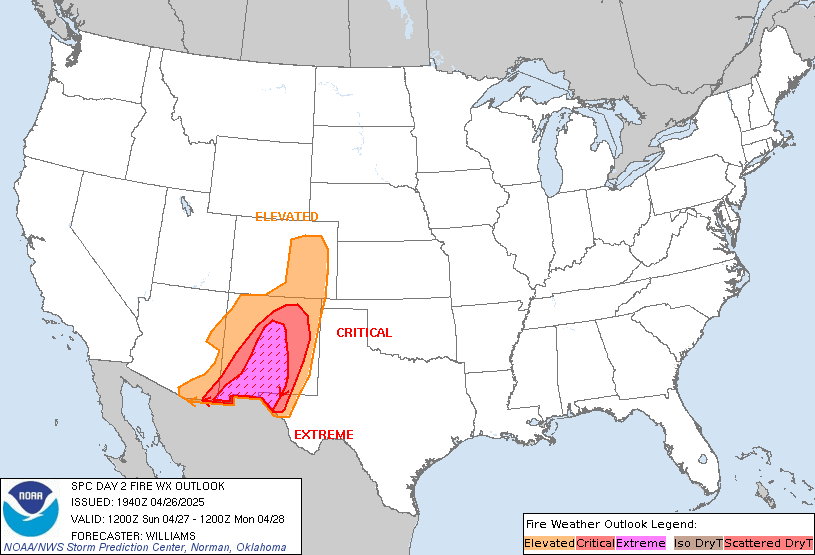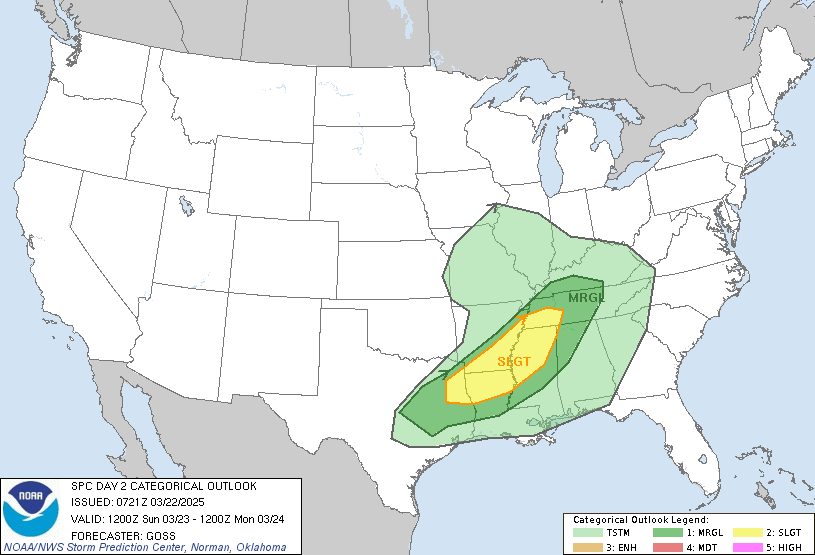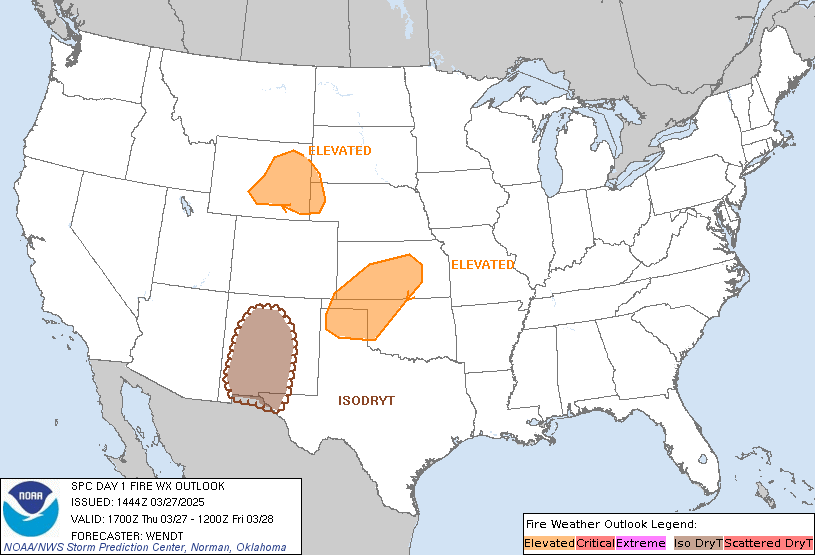(date: 2024-02-24 18:31:22)
date: 2024-02-23, from: NOAA tornado/severe thunderstorm watches, mesoscale discussions, convective outlooks, fire weather outlooks

Day 1 Convective Outlook NWS Storm Prediction Center Norman OK 0149 PM CST Fri Feb 23 2024 Valid 232000Z - 241200Z ...NO SEVERE THUNDERSTORM AREAS FORECAST... ...SUMMARY... The risk for severe storms appears negligible across the U.S. through tonight. ...20Z Update... The primary, and increasing, thunderstorm development has become focused offshore, in a narrow pre-cold frontal corridor, downstream of one increasingly sheared short wave perturbation within broader-scale cyclonic, southwesterly mid-level flow. As this continues to overspread middle into southern Atlantic coastal areas late this afternoon through tonight, higher thunderstorm probabilities will remain offshore. However, near pre-frontal surface troughing still overspreading portions of northern Florida and southeastern Georgia into South Carolina, cooling aloft is contributing to steeping low-level lapse rates, with boundary-layer moisture sufficient to contribute to weak ongoing destabilization. This is already supporting the initiation of widely scattered weak thunderstorm development, which may persist across the South Carolina Piedmont into coastal plain, and portions of the southeast Georgia coastal plain vicinity, into early evening. West of the Appalachians, deepening convection is evident within a narrow plume of warmer low-level air/stronger boundary-layer heating spreading into the Allegheny and Cumberland Plateau vicinity. Lightning has recently been detected across parts of northwestern Alabama into northern middle Tennessee, and further convective development capable of generating occasional lightning beneath seasonably mid-level air remains possible. Based on various ensemble output and NAM/Rapid Refresh forecast soundings, this potential (though with probabilities generally near the minimum threshold for a categorical thunder area) may become maximized across parts of the Allegheny Plateau late this afternoon, perhaps aided by somewhat stronger mid/upper forcing for ascent overspreading that region. ..Kerr.. 02/23/2024 .PREV DISCUSSION... /ISSUED 1003 AM CST Fri Feb 23 2024/ ...Carolinas... Morning surface analysis shows a low over VA with a trailing cold front extending southwestward into the Gulf Coast states. This front will sweep southeastward today across the Carolinas. Cloud cover is diminishing across SC ahead of the front, which should result in some heating/destabilization. However, this heating will be behind a pre-frontal trough, where veering surface winds are weakening low-level convergence and shear. Cold temperatures aloft and steep lapse rates may still result in a few afternoon thunderstorms, with small hail possible in the stronger cells. However, guidance appears less favorable for severe storms than earlier anticipated.
https://www.spc.noaa.gov/products/outlook/day1otlk_2000.html Save to Pocket
date: 2024-02-23, from: NOAA tornado/severe thunderstorm watches, mesoscale discussions, convective outlooks, fire weather outlooks

Day 2 Fire Weather Outlook NWS Storm Prediction Center Norman OK 0136 PM CST Fri Feb 23 2024 Valid 241200Z - 251200Z ...NO CRITICAL AREAS... Dry and breezy conditions remain probable across the southern High Plains into parts of the central Plains. General lack of fuel receptiveness will keep concerns localized. Ahead of a secondary cold front, dry and windy conditions also can be anticipated in parts of the Southeast. Winds of 15-20 mph (with greater gusts) will coincide with RH that could fall below 30%. Fuels appear to be marginally dry, though perhaps drier than usual for this time of year. Without greater confidence in sufficiently dry fuels, only locally elevated conditions are expected. ..Wendt.. 02/23/2024 .PREV DISCUSSION... /ISSUED 0152 AM CST Fri Feb 23 2024/ ...Synopsis... An upper-level ridge will build in across the western US with downstream troughing across the east D2/Saturday through the remainder of the weekend. Surface high pressure over the Plains will slowly weaken allowing for increasing winds through the day. Southerly dry return flow will increase across the southern High Plains and breezy northwest flow is expected in the lee of the Rockies and central High Plains. While breezy, poor overlap of gusty winds, low humidity and dry fuels is expected. As such, fire weather concerns will remain low for much of the CONUS. Locally dry and breezy conditions are possible across parts of the northern/central Plains and central TX. However, fuels across these regions are less receptive to fire spread suggesting fire-weather concerns will remain localized. ...Please see www.spc.noaa.gov/fire for graphic product...
https://www.spc.noaa.gov/products/fire_wx/fwdy2.html Save to Pocket
date: 2024-02-23, from: NOAA tornado/severe thunderstorm watches, mesoscale discussions, convective outlooks, fire weather outlooks

Mesoscale Discussion 0157
NWS Storm Prediction Center Norman OK
1125 AM CST Fri Feb 23 2024
Areas affected...northern Florida into southeast Georgia and
southern South Carolina
Concerning...Severe potential...Watch unlikely
Valid 231725Z - 232030Z
Probability of Watch Issuance...5 percent
SUMMARY...A gradual increase in convective coverage is possible over
the next several hours, and localized strong gusts may occur.
DISCUSSION...A strong upper trough with cooling aloft continues to
rapidly overspread the region, with a cold front now extending from
central SC into the FL Panhandle. A narrow plume of warming
temperatures and dewpoints to around 60 F extend from the FL
Panhandle across southeast GA and toward southern SC, and is
contributing to up to 500 J/kg SBCAPE.
Modified soundings from the area depict generally shallow storm
potential, however, if cooling aloft can remove the midlevel warm
layer prior to the cold front moving offshore, a brief period may
exist for deeper convection. Given the strong deep-layer wind
fields, but generally weak instability, localized wind damage would
appear to be the main concern.
..Jewell/Hart.. 02/23/2024
...Please see www.spc.noaa.gov for graphic product...
ATTN...WFO...CHS...CAE...JAX...FFC...TAE...
LAT...LON 30248148 30138246 30128256 30228292 30418318 30708341
31018342 31328332 31568289 31838239 32588165 33718090
33568021 33157970 32727976 32398033 32008076 31588109
31028134 30668137 30248148
https://www.spc.noaa.gov/products/md/md0157.html Save to Pocket
date: 2024-02-23, from: NOAA tornado/severe thunderstorm watches, mesoscale discussions, convective outlooks, fire weather outlooks

Day 2 Convective Outlook NWS Storm Prediction Center Norman OK 1122 AM CST Fri Feb 23 2024 Valid 241200Z - 251200Z ...NO SEVERE THUNDERSTORM AREAS FORECAST... ...SUMMARY... Scattered thunderstorms are possible across parts of the Carolinas Saturday afternoon, but the risk of severe weather currently appears negligible. ...Synopsis... A more prominent blocking regime is evolving across the southern mid-latitude and subtropical eastern Pacific, with split belts of stronger westerlies becoming broadly confluent into/across the North American Pacific coast. Downstream, an initially amplified regime, including large-scale mid/upper troughing across much of eastern North America, may begin to slowly trend more zonal by the end of the period. While one vigorous embedded short wave impulse of Arctic origins turns eastward across the St. Lawrence Valley through the Canadian Maritimes, a couple of consolidating trailing perturbations (also emanating from the Arctic) are forecast to continue digging southeast of the lower Ohio Valley through the southern Mid Atlantic coast vicinity, before turning eastward into the Atlantic. Associated with these developments, in lower levels, models indicate that modifying Arctic air will be in the process of overspreading New England and northern Mid Atlantic coastal areas by daybreak Saturday, with a secondary surge overspreading the southern Appalachians and much of the Southeast Saturday afternoon through Saturday night. This will be preceded by a more modest surface front, initially stalling across the Canadian Maritimes, while advancing southeast of the Florida Peninsula, and well away from much of the remainder of the southern Atlantic Seaboard by early Saturday. In the wake of this lead front, low-level drying appears likely to continue across the southeastern Gulf of Mexico into the Caribbean. Generally dry conditions likely will prevail across much of the remainder of the Gulf Basin, though models suggest that some boundary-layer modification/moistening may slowly commence in a narrow corridor near the Mexican/northwestern Gulf coast vicinity. ...Carolinas... While boundary-layer moisture content will remain relatively low, insolation likely will contribute to steep low-level lapse rates ahead of the reinforcing cold front, and beneath a cold mid-level environment across most areas south and east of the southern Appalachians by Saturday afternoon. As a 70-90 kt mid-level jet streak (associated with the approaching Arctic impulse) noses toward the southern Atlantic coast, models suggest that forcing for ascent and cold advection may contribute to 500 mb temperatures cooling to as low as -28 to -30 C across the Carolinas Saturday afternoon. It appears that this will contribute to sufficient destabilization to support low topped thunderstorm development, initiating over the higher terrain before spreading east-southeastward into the coastal plain by early Saturday evening. Based on forecasting soundings, the risk for severe weather appears low. However, it may not be entirely out of the question that stronger cells could produce small hail or graupel and perhaps scattered gusts up to around 30-40 kt. ..Kerr.. 02/23/2024
https://www.spc.noaa.gov/products/outlook/day2otlk_1730.html Save to Pocket
date: 2024-02-23, from: NOAA Weather Forecasts

Day 1 Fire Weather Outlook NWS Storm Prediction Center Norman OK 1033 AM CST Fri Feb 23 2024 Valid 231700Z - 241200Z ...NO CRITICAL AREAS... No changes to the ongoing forecast. ..Wendt.. 02/23/2024 .PREV DISCUSSION... /ISSUED 0151 AM CST Fri Feb 23 2024/ ...Synopsis... In the mid levels, troughing is forecast to intensify over the eastern US as ridging builds over the West Coast. Strong mid-level flow will shift over the east as high pressure begins to move into the central US. At the surface, a weak cold front will move offshore with north/northwesterly winds likely behind it. While weaker winds are expected over much of the CONUS, somewhat stronger flow is possible in the lee of the Rockies over parts of the High Plains this afternoon. Localized dry and breezy conditions may emerge across portions of NE, CO, and KS. However, stronger winds will be limited in overlap with dry fuels suggesting fire-weather concerns will be limited for much of the country. ...Please see www.spc.noaa.gov/fire for graphic product...
https://www.spc.noaa.gov/products/fire_wx/fwdy1.html Save to Pocket
date: 2024-02-23, from: NOAA tornado/severe thunderstorm watches, mesoscale discussions, convective outlooks, fire weather outlooks

Day 1 Convective Outlook NWS Storm Prediction Center Norman OK 1003 AM CST Fri Feb 23 2024 Valid 231630Z - 241200Z ...NO SEVERE THUNDERSTORM AREAS FORECAST... ...SUMMARY... No organized severe storms are expected today. ...Carolinas... Morning surface analysis shows a low over VA with a trailing cold front extending southwestward into the Gulf Coast states. This front will sweep southeastward today across the Carolinas. Cloud cover is diminishing across SC ahead of the front, which should result in some heating/destabilization. However, this heating will be behind a pre-frontal trough, where veering surface winds are weakening low-level convergence and shear. Cold temperatures aloft and steep lapse rates may still result in a few afternoon thunderstorms, with small hail possible in the stronger cells. However, guidance appears less favorable for severe storms than earlier anticipated. ..Hart/Bentley.. 02/23/2024
https://www.spc.noaa.gov/products/outlook/day1otlk_1630.html Save to Pocket
date: 2024-02-22, from: NOAA tornado/severe thunderstorm watches, mesoscale discussions, convective outlooks, fire weather outlooks

Day 1 Convective Outlook CORR 1 NWS Storm Prediction Center Norman OK 0818 AM CST Thu Feb 22 2024 Valid 221300Z - 231200Z ...THERE IS A MARGINAL RISK OF SEVERE THUNDERSTORMS OVER PARTS OF THE MID-SOUTH REGION... CORRECTED FOR TYPO ...SUMMARY... Thunderstorms may produce marginally severe gusts or hail this afternoon and evening over parts of the Mid-South region. ...Synopsis... In the mean, mid/upper-level pattern amplification should begin again during this period, as ridging builds over NV, the Pacific Coast States and interior Northwest. Downstream, a series of shortwaves will contribute to substantial synoptic-scale height falls over much of the Mississippi and Ohio Valleys to the central Gulf Coast. None of those perturbations -- including some apparent in moisture-channel imagery over OK, northern KS/NE, and western CO -- are (or will become) particularly intense, but should contribute to at least weak large-scale destabilization aloft and maintenance or strengthening of cyclonic flow. At the surface, 11Z analysis showed a cold front extending from a low over southeastern ON across northern IN, through weak lows over central MO and near TUL, then across northwest TX to southern NM. The front should move eastward and southeastward today, to a 00Z position over eastern/southern OH, the lowest Ohio Valley, eastern/ southern AR, and northeast to south-central TX. By 12Z, the front should reach central NY, eastern PA, the southern Appalachians, central parts of MS/LA, and shelf waters of the northwestern Gulf. ...Mid-South region... Isolated to widely scattered thunderstorms are expected to develop by late this afternoon along/ahead of the cold front, over central/ eastern AR and perhaps western TN. Activity should strengthen and increase in coverage through evening as it encounters greater moisture across the Mississippi Valley and into northern portions of MS tonight. Some upscale organization into a short QLCS is possible from early multicell to supercell modes. Marginally severe hail and damaging gusts will be the main concerns. The outlook area will reside on the southwestern rim of a far larger swath of general thunderstorm potential, but with access to sustained, effectively surface-based and at least marginally moist inflow parcels beginning mid/late afternoon in AR and shifting east- southeastward with time. Progs that generate little substantial convection generally are too cool at the surface. Forecast max surface temperatures in the mid/upper 60s F over much of the area will support favorable low-level lapse rates, as well as some boundary-layer mixing, amidst potential for localized downward momentum transfer from stronger flow aloft, for gust support. Midlevel lapse rates are not expected to be very strong, limiting MLCAPE to around 250-750 J/kg, and likely keeping the hail potential isolated, marginal and conditional to supercell maturation. Sufficient deep shear will exist for that, however, with modified forecast soundings indicating around 40-45-kt effective-shear magnitudes and 150-250 J/kg effective SRH -- despite prefrontal veering with time of surface winds toward southwesterly. Greater diurnal boundary-layer mixing/drying, EML-related CINH and weaker CAPE will likely restrict severe potential around western parts of the outlook, while instability decreases northward, moisture decreases eastward, and lift weakens southward. ..Edwards.. 02/22/2024
https://www.spc.noaa.gov/products/outlook/day1otlk_1300.html Save to Pocket